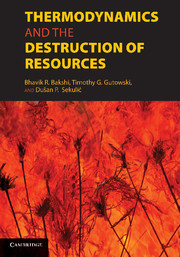Book contents
- Frontmatter
- Contents
- Contributor List
- Foreword by Herman E. Daly
- Foreword by Jan Szargut
- Preface
- Introduction
- PART I FOUNDATIONS
- PART II PRODUCTS AND PROCESSES
- 4 Materials Separation and Recycling
- 5 An Entropy-Based Metric for a Transformational Technology Development
- 6 Thermodynamic Analysis of Resources Used in Manufacturing Processes
- 7 Ultrapurity and Energy Use: Case Study of Semiconductor Manufacturing
- 8 Energy Resources and Use: The Present Situation, Possible Sustainable Paths to the Future, and the Thermodynamic Perspective
- PART III LIFE-CYCLE ASSESSMENTS AND METRICS
- PART IV ECONOMIC SYSTEMS, SOCIAL SYSTEMS, INDUSTRIAL SYSTEMS, AND ECOSYSTEMS
- Appendix: Standard Chemical Exergy
- Index
- References
5 - An Entropy-Based Metric for a Transformational Technology Development
Published online by Cambridge University Press: 01 June 2011
- Frontmatter
- Contents
- Contributor List
- Foreword by Herman E. Daly
- Foreword by Jan Szargut
- Preface
- Introduction
- PART I FOUNDATIONS
- PART II PRODUCTS AND PROCESSES
- 4 Materials Separation and Recycling
- 5 An Entropy-Based Metric for a Transformational Technology Development
- 6 Thermodynamic Analysis of Resources Used in Manufacturing Processes
- 7 Ultrapurity and Energy Use: Case Study of Semiconductor Manufacturing
- 8 Energy Resources and Use: The Present Situation, Possible Sustainable Paths to the Future, and the Thermodynamic Perspective
- PART III LIFE-CYCLE ASSESSMENTS AND METRICS
- PART IV ECONOMIC SYSTEMS, SOCIAL SYSTEMS, INDUSTRIAL SYSTEMS, AND ECOSYSTEMS
- Appendix: Standard Chemical Exergy
- Index
- References
Summary
Introduction
Discussion about sustainable development should start with a rigorous definition of what sustainability is in the context of utilization of natural, human, and manufactured resources. A necessary next step in implementing any such definition should be a selection of metrics for measuring a departure of a given system from sustainability thus defined. However, two main interrelated weaknesses of most efforts devoted to formulating definitions and establishing sustainability metrics have been quite visible. First, sustainability is often defined in only a somewhat qualitative manner across several disciplines, and, second, as a consequence, too many and too diverse sets of proposed metrics have been introduced – without any consensus among the proposers. Thus proclaiming a sustainable development analysis as a well-structured discipline would be premature. In general, it has been assessed that “sustainable development has broad appeal and little specificity” [1] Hence my position would be that this field of inquiry in general cannot yet be interpreted as a coherent “science of sustainability,” although a need for establishing such a science (science of sustainability) has already been promoted [2].
Reasons for that state of affairs are multiple (and inevitably involve a significant level of misconceptions among participants in this notoriously transdisciplinary domain). Let us illustrate this statement by a prominent example of the Bruntdland definition of sustainable development. This definition has inspired most of the early development in this field and still is the one most cited. However, it can hardly be described as precise and rigorous.
- Type
- Chapter
- Information
- Thermodynamics and the Destruction of Resources , pp. 133 - 162Publisher: Cambridge University PressPrint publication year: 2011
References
- 3
- Cited by

